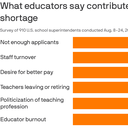Quantifying an "alarming" teacher shortage

Two-thirds of U.S. public school superintendents say overall vacancies — including teachers and non-instructional staffers — are higher this year than last, a survey by AASA, The School Superintendents Association, found.
- About 15% report a lot more openings, saying vacancy rates are 11%-30% higher than last year.
- And 85% of superintendents in the AASA survey say they don't have enough applicants.
Why it matters: COVID-19 has accelerated a relentless national teacher shortage that has school districts taking desperate measures to fill classrooms even as students play catch-up from pandemic-era learning deficits.
- Des Moines is offering $50,000 pay incentives to teachers; states like Florida and Arizona are waiving degree and experience requirements.
The big picture: A slow leak of teachers from the nation's public schools was starting to reach crisis proportions before the pandemic, and COVID-19 made things worse.
- A seminal 2019 report by the Economic Policy Institute called the teacher shortage "real, large and growing, and worse than we thought." It found that high-poverty schools suffer the most from the shortage of credentialed teachers.
- When the pandemic struck in 2020, teachers' jobs got harder — and more danger0us — as students' needs grew and parents and communities started demanding more from them.
- "Burnout and the desire for better pay" are the top reasons teachers leave, Noelle Ellerson Ng of the AASA tells Axios.
The AASA survey, released Monday, found that the pandemic did "magnify the teacher shortage, amplify the inequities of vacancies, and force the nation to really look at what we expect of educators in the context of the important work they do."
- The superintendents' group called the problem "complex," with "multiple factors driving educators away from the field, including relatively low pay, poor working environments, uneven or absent opportunities for professional growth, and the weak prestige of teaching."
By the numbers: Of the more than 900 superintendents surveyed from August 8-24, the vast majority — 78% — said the vacancy rate on their teaching staff was 0-5%.
- 14% reported a teacher vacancy rate of 6%-10%
- 4.7% said the rate was 11%-15%, and 1.4% said it was 16%-20%.
While most of the superintendents reported more vacancies than last year, some did not: 24% said their vacancy rate was unchanged or comparable, while 9% said it was lower than last year.
- The AASA did not ask about earlier years, nor did it have comparable survey data.
Be smart: Those nationwide numbers don't necessarily scream "major shortage," but for individual districts having trouble finding staff, this is a real crisis.
Of note: Schools have been expanding their staffs to meet the heightened needs of students for mental health counseling and extra help with classwork — that's why the AASA survey asked about vacancy percentages rather than absolute numbers.
- The Biden administration has encouraged schools to use pandemic relief funds to create new positions, increase pay and take advantage of expanding teacher apprenticeship programs.
Yes, but: Pandemic funding comes with time limits, and "school districts have to think about what it means when those dollars dry up," Ellerson Ng said.
- "Are they going to be able to continue to provide those services?" she said.
- Parents, she added, aren't going to understand when a district tells them that all the elementary school therapists had to be cut.
The bottom line: "We need to build a better pipeline of educators," said Daniel Domenech, executive director, AASA, in a press release. "The exodus of education leaders is alarming and will have long-lasting effects."